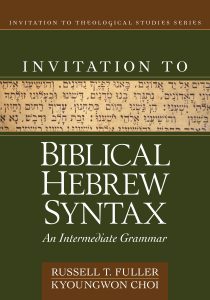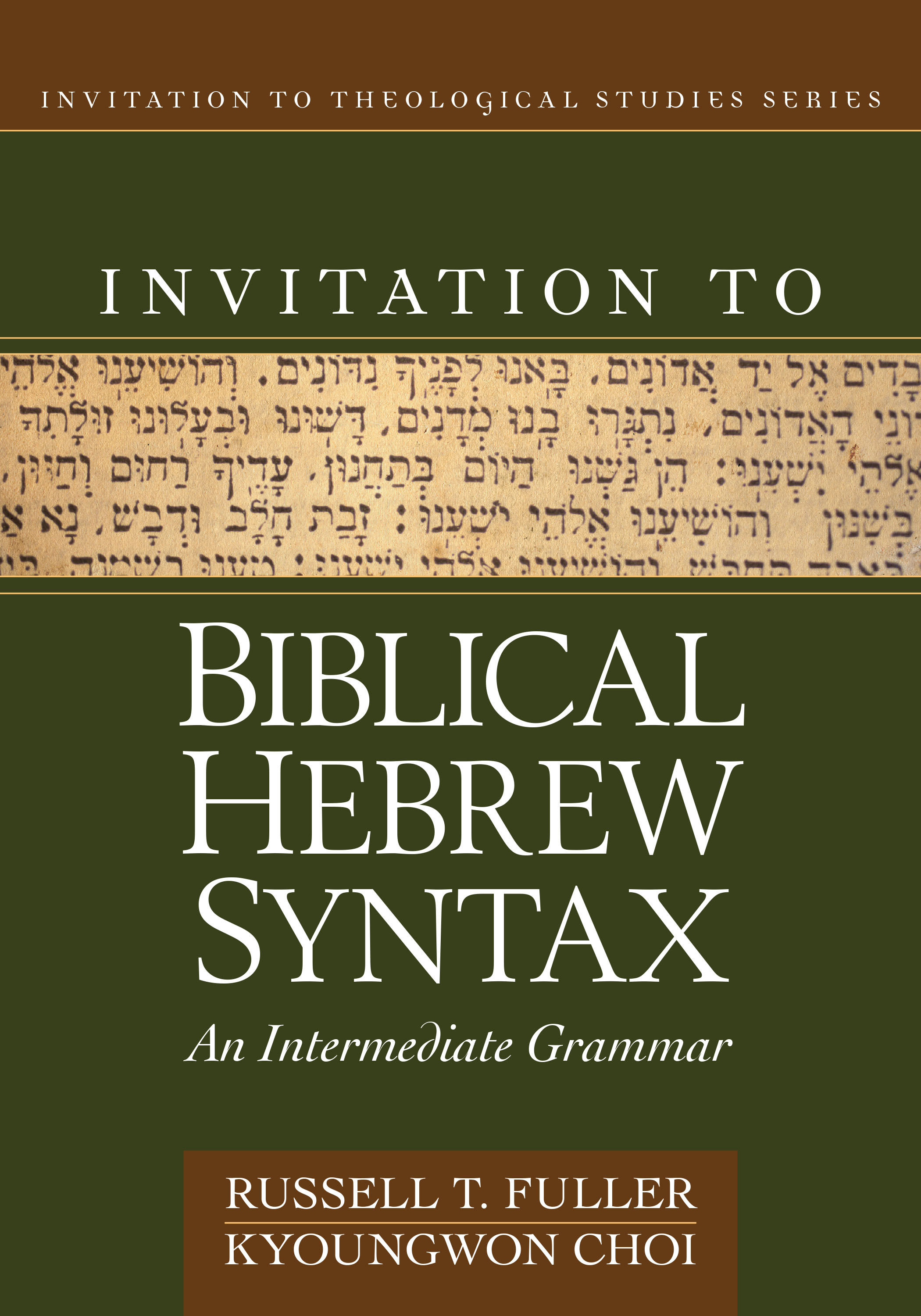Fuller, Russell T. and Choi, Kyoungwon. Invitation to Biblical Hebrew Syntax: An Intermediate Grammar. Kregel: Grand Rapids, 2017, pp. 528, $64.99, hardback.
Fuller and Choi’s Invitation to Biblical Hebrew Syntax (IBHS) is a thorough discussion of biblical Hebrew syntax from a traditional Semitic approach. The book serves as a companion to their elementary Hebrew textbook: Invitation to Biblical Hebrew. Whereas the elementary grammar focused on morphology, the intermediate grammar focuses on syntax. Fuller is an expert of Hebrew morphology and syntax and was trained at Hebrew Union University in Cincinnati, OH. Choi too is an expert in Hebrew studies. He received his training under Fuller from SBTS. The widespread use of the author’s elementary grammar to train thousands of students in biblical Hebrew leads to great expectation; IBHS exceeds expectations.
The book is divided into three main sections: The first section is a discussion of biblical Hebrew syntax proper (pp. 21–237). Although these discussions occupy the bulk of other Hebrew syntax books, this section comprises around half of IBHS. This section of the book is arranged in outline form and by section number. Moreover, grammatical terms are represented in all caps. Concise definitions of these terms are found in the first appendix (pp. 417–424). Footnotes in this section serve to vital purposes: 1) they explain in greater detail the syntax under discussion, and 2) they refer students to the appropriate section numbers of other Hebrew syntax books. Exercises accompany each syntactical discussion. These exercises include questions assessing basic comprehension while drills force students to identify and analyze.
The second section of the book is the compositions. This section begins with a discussion on methodology: namely, how to use and work through this vital section of the book. The compositions follow. Initially, the reader finds an English composition. The same English composition follows but with the addition of several footnotes describing the appropriate Hebrew syntax to be used in translating. Citations to syntactical discussions abound in this section. Based on this document, the student is to compose the English into biblical Hebrew. A key accompanies the composition. Finally, an unpointed Hebrew key concludes each composition. The first eight compositions are prose while the final four are poetry.
The third section is a discussion of prose and poetry accents. This section describes the accents and their purpose in detail. Examples and diagrams abound in this section to aid comprehension. The section concludes with a commentary on the accents of the seventh composition found in the book and of Psalm 1. In this way, the authors provide an illustration of the principles discussed throughout the section.
This book has several strengths. First, throughout the book, students will see that Hebrew syntax is constantly compared and contrasted to other Semitic languages. This characteristic pervades the book because of the author’s approach to interpreting biblical Hebrew; namely, they argue that Semitic languages ought to be the lens whereby one interprets and explains Hebrew syntactical constructions (see their discussion on pp. 11–12). By incorporating other Semitic languages into the discussions, the authors achieve several noble ends. 1) The authors provide the student the ability to make connections about how and why Hebrew developed which alleviates the language’s “foreignness” (see the discussion of the imperfect on p. 28). 2) This characteristic is an encouragement to the students to learn other Semitic languages. This is a certain strength.
Second, the book provides the students with ample opportunity to practice the skills taught in the book. The exercises and drills in the first section and the compositions in the second section are all examples of this strength. The emphasis on practicing the basics of Hebrew syntax is a characteristic that sets this book apart from others and is rooted in the authors traditional pedagogy. The result of this characteristic is that students are able, not merely to identify Hebrew syntax, but they are able to create it. Those who can create Hebrew syntax will not only know more than those trained merely to recognize the syntax, but they will read the actual text of the Bible with greater ease.
Third, the book provides a thorough discussion of the Hebrew accents. The accents are often relegated to secondary or tertiary importance in Hebrew studies because they were added to the consonantal text long after the consonants. Despite their late addition, they are of vital importance since the accents often determine sense units like English punctuation marks. Although the accents are important to the proper understanding of Hebrew syntax, they are often neglected in Hebrew studies. This critique cannot be leveled against IBHS. The discussions of the accents are thorough while the compositions provide the student the opportunity to construct Hebrew with the accents. A clear strength of this book is the opportunity it provides the student to master the accents through identification and composition.
Perhaps one weakness of the book is the lack of vocabulary that accompanies each chapter. Of course, this book is a syntax book, and vocabulary is not a syntactical category. Nonetheless, the book will be used by many third semester Hebrew courses. Since the ability to recognize Hebrew vocabulary is essential to reading the Hebrew Bible – this is the hope of the authors (10) – the inclusion of vocabulary at the end of each chapter would have been a welcomed addition.
Overall, IBHS stands out among Hebrew syntax books. It provides a thorough discussion of the syntactical categories while offering the student ample opportunities to practice their newly learned skills. Students will find this book both challenging and fun as they grow in their understanding and love of biblical Hebrew. It might even invigorate many students to master other Semitic languages for glory of the Lord!
Anthony Ferguson, Gateway Seminary





